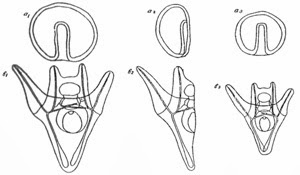In 1815 Augusta Ada Byron was born. She was the only offspring of Lord Byron from his wedding with Anne Isabella Milbanke. She is also known as Ada Lovelace because of her wedding with William King, Earl of Lovelace. She had an impressive mathematical talent and contributed to the writing of a paper on an Analytical Engine (a predecessor of computers-that was never constructed) entitled “Sketch of the Analytical Engine, with Notes from the Translator”. Her notes are considered to be the first computer program. This paper was a major inspiration on Turing's work on modern computers several decades later.
 She could also foresee the vast abilities of computers suggesting that they could be used in music or to solve problems of any complexity while her contemporary scientists considered computers as mere number-crunching devices.
She could also foresee the vast abilities of computers suggesting that they could be used in music or to solve problems of any complexity while her contemporary scientists considered computers as mere number-crunching devices.
Unfortunately, Ada Lovelace died few years after the publication of this paper at the age of 36. However, she has been a powerful symbol of women in technology and science ever since.
On October 15th we are honouring Ada Lovelace and all the achievements of women in science and technology. One of these women whose contribution has been, according to my opinion, under-recognised is Ethel Browne Harvey. Born in 1885 in Baltimore, she did her PhD in Columbia University under the supervision of Edmund Beecher Wilson. She spent the biggest part of her research career at Princeton University but she also worked at the Marine Biological Laboratory (MBL) at Woods Hole, in Massachusetts, at the Cornell Medical College, and also contacted research in Japan, Bermuda, North Carolina, California, Monaco and Naples.
 She developed a lifelong interest in the role of the nucleus and cytoplasm in inheritance and development studying mainly sea urchins. Her work on differentiation and development was impressive and she was one of only three women that were invited to give a talk at the prestigious Friday Evening lectures at the MBL over the 50 first years of the existence of the institute.
She developed a lifelong interest in the role of the nucleus and cytoplasm in inheritance and development studying mainly sea urchins. Her work on differentiation and development was impressive and she was one of only three women that were invited to give a talk at the prestigious Friday Evening lectures at the MBL over the 50 first years of the existence of the institute.
Her 1909 paper titled "The production of new hydranths in hydra by the insertion of small grafts" was the first published experimental result demonstrating that a transplant could induce a second axis of polarity at the host organism. More specifically, in that set of experiments Harvey grafted the tissue that makes up the mouth of an hydra to a certain site in the body wall of another hydra and proved that this was enough to provoke the development of a new "hydrath" at that site.

Original drawings from Ethel Browne's paper (1909). At her experiments, she
removed a part of the hypostome with a single tentacle of an hydra and
transplanted it to the side of another hydra. This induced a second
axis of polarity (2) which resulted in the growing of a secondary
hydrath (3). Picture taken from Lenhoff H, Biol.Bull. 181:72-80, 1991
Later Spemann and Mangold showed the same phenomenon in salamander eggs which resulted in Spemann being awarded the Nobel Prize in Medicine in 1935. Spemann didn't cite Harvey's findings in his paper and we are not sure whether he was aware of them or not although Lenhoff -in his paper "Ethel Browne, Hans Spemann, and the Discovery of the Organizer Phenomenon"- shows evidence that Spemann had indeed read Harvey's paper before designing his famous experiments. We also don't know whether the Nobel Prize committee was unaware of her discoveries before they awarded the Nobel to Spemann.
Harvey was a pioneer in developmental biology that I don't think that she received the recognition she deserved for her contributions. However, her determination and devotion to what she loved doing make her one of my personal heroes.
 |
| Happy Ada Lovelace Day!!! |
Further reading....
1. Notable American Women: The Modern Period : a Biographical Dictionary, by Barbara Sicherman, Carol Hurd Green, Harvard University Press
2. Howard Lenhoff, Ethel Browne, Hans Spemann, and the Discovery of the Organizer Phenomenon, Biol. Bull. 181: 72-80. 1991



















.JPG)









.JPG)








